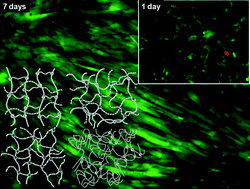Novel gelatin–PHEMA porous scaffolds for tissue engineering applications
Abstract
In the present work, novel bicomponent polymeric hydrogels based on methacrylamide-modified gelatin (MAG) and

Maintenance work is planned for Wednesday 1st May 2024 from 9:00am to 11:00am (BST).
During this time, the performance of our website may be affected - searches may run slowly and some pages may be temporarily unavailable. If this happens, please try refreshing your web browser or try waiting two to three minutes before trying again.
We apologise for any inconvenience this might cause and thank you for your patience.
* Corresponding authors
a
Advanced Polymer Materials Group, University Politehnica of Bucharest, 149 Calea Victoriei, Bucharest, Romania
E-mail:
izabela.cristina.stancu@gmail.com
Tel: +40 214022718
b
Polymer Chemistry and Biomaterials Group, Ghent University, Krijgslaan 281 (S4), B-9000 Ghent, Belgium
Tel: +32 (0)92644501
c Department of Subatomic and Radiation Physics, Ghent University, Proeftuinstraat 86, B-9000 Ghent, Belgium
d Department of Basic Medical Sciences, Ghent University, De Pintelaan 185 6B3, B-9000 Ghent, Belgium
In the present work, novel bicomponent polymeric hydrogels based on methacrylamide-modified gelatin (MAG) and

 Please wait while we load your content...
Something went wrong. Try again?
Please wait while we load your content...
Something went wrong. Try again?
D. Dragusin, S. Van Vlierberghe, P. Dubruel, M. Dierick, L. Van Hoorebeke, H. A. Declercq, M. M. Cornelissen and I. Stancu, Soft Matter, 2012, 8, 9589 DOI: 10.1039/C2SM25536G
To request permission to reproduce material from this article, please go to the Copyright Clearance Center request page.
If you are an author contributing to an RSC publication, you do not need to request permission provided correct acknowledgement is given.
If you are the author of this article, you do not need to request permission to reproduce figures and diagrams provided correct acknowledgement is given. If you want to reproduce the whole article in a third-party publication (excluding your thesis/dissertation for which permission is not required) please go to the Copyright Clearance Center request page.
Read more about how to correctly acknowledge RSC content.
 Fetching data from CrossRef.
Fetching data from CrossRef.
This may take some time to load.
Loading related content
